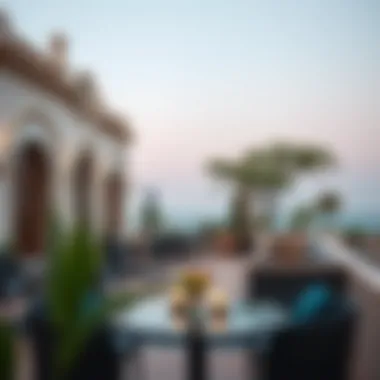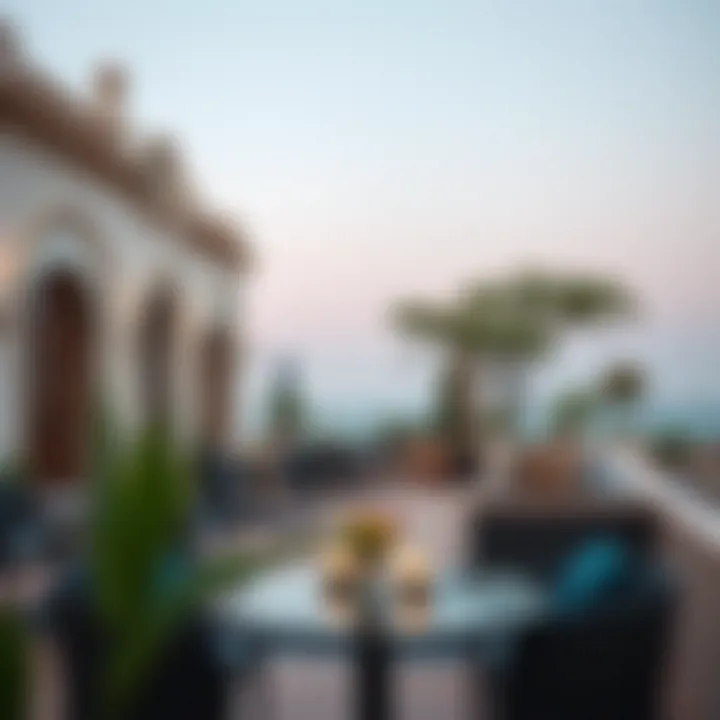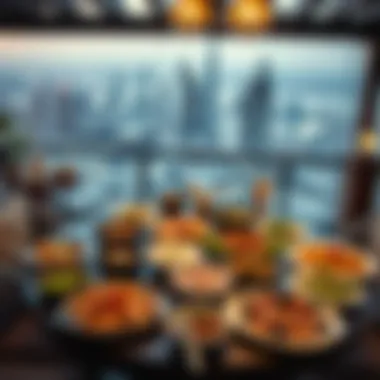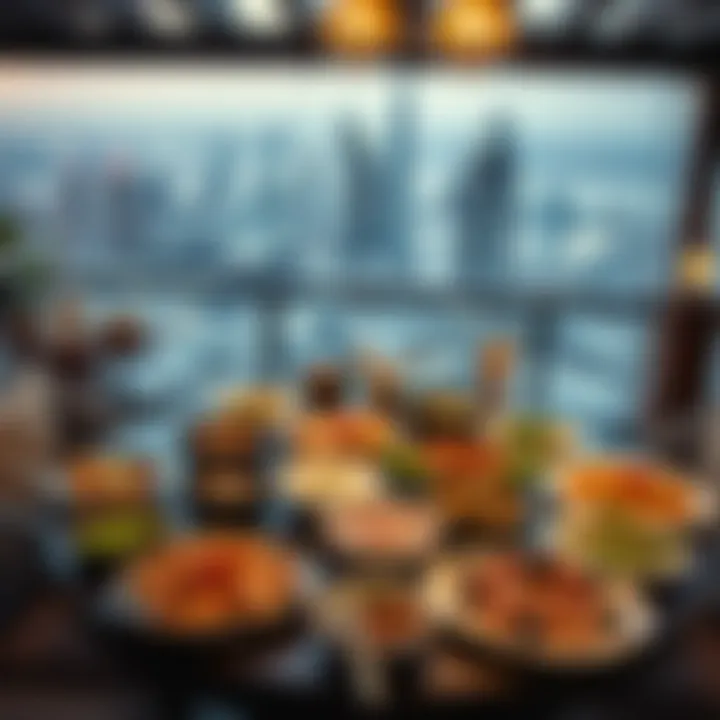Rooftop Dining in Dubai: A Unique Culinary Experience


Intro
The skyline of Dubai, punctuated by towering skyscrapers and architectural wonders, is more than just a backdrop; it is a canvas for a culinary adventure high above the ground. Dining at rooftop restaurants in Dubai offers an immersive experience that goes beyond mere food. It encompasses stunning views, innovative designs, and a fusion of flavors that cater to a wide spectrum of tastes. For those seeking a unique combination of ambiance and cuisine, these rooftop venues stand out, presenting a perfect intersection of the city's impressive architecture and its vibrant food scene.
This article aims to take readers on a journey through the unseen world of Dubai's rooftop dining. We'll explore the myriad culinary offerings, discuss the architectural significance of each restaurant, and delve into how the climate affects the dining experience — both positively and negatively. With seasonal changes and the city's unique atmosphere, dining on these heights comes with its own set of challenges and delights.
In addition to highlighting specific venues, we will also touch upon essential considerations like accessibility to these restaurants and the impact of weather on outdoor dining. Whether you're an investor looking to tap into this burgeoning market or a curious diner wanting to explore a new culinary landscape, this guide provides ample insights to navigate the rooftop dining scene in Dubai.
Prelims to Rooftop Dining in Dubai
Rooftop dining in Dubai has swiftly become one of the most sought-after gastronomic experiences, offering not only delectable dishes but also staggering views of one of the world’s most iconic skylines. When you sit down for a meal hundreds of feet above the ground, it’s more than just dinner; it's a multi-sensory experience that encompasses the sights, sounds, and tastes of this vibrant city. This section delves into the very essence of what makes dining atop these elevated venues so enticing, revealing the nuances that seduce both local dwellers and international visitors alike.
Defining the Rooftop Dining Experience
The term "rooftop dining" brings to mind images of lush surroundings, chic décor, and a breathtaking panorama stretching across the vast horizon. At its core, it encapsulates a culinary indulgence that pairs exquisite fare with the dramatic backdrop of the city’s skyline. This dining experience transcends simple meals; it engages all the senses. Picture this: vibrant sunset glow as the backdrop while enjoying a crafted cocktail or a sumptuous dinner prepared by world-renowned chefs.
It's about finding that perfect spot where the sky kisses the city, turning an ordinary dining occasion into an extraordinary event. Patrons are not merely looking for food but are after an immersion into an ambiance that echoes luxury, creativity, and exclusivity. Each rooftop restaurant presents an opportunity to experience diverse culinary traditions, all while soaking up the bustling energy of Dubai from above.
The Allure of Elevated Venues
The attraction to elevated dining venues extends beyond mere aesthetics. For many, it's about being part of a unique social fabric, where gatherings are not just meals but celebrations of life, achievements, and companionship. A table set against the backdrop of the sun dipping below the horizon becomes a canvas of conversations and shared laughter, creating memories that linger long after the plates are cleared.
Moreover, these rooftop establishments often showcase innovative design elements that appeal to the creative soul. From sleek modern architecture to intimate hideaways adorned with lush greenery, they are as much about visual pleasure as they are about culinary excellence. Here’s why elevated venues hold such a magnetic appeal:
- Breathtaking Views: Gazing over the Dubai skyline at night, when everything is lit up, feels magical.
- Sophisticated Ambiance: The atmosphere is often infused with an air of exclusivity, making every visit feel special.
- Culinary Adventure: Many rooftop venues pride themselves on creative menus that fuse local flavors with international cuisines.
- Social Interaction: These spots serve as social hubs, fostering interactions amongst diverse patrons, from families to business executives.
Each visit to a rooftop dining venue offers something new, whether it’s a seasonal menu change or a special event, ensuring that there’s always a reason to return. As Dubai continues to evolve, so does the landscape of its rooftop dining, promising an unending journey through flavor and ambiance.
Cultural Significance of Rooftop Dining
Rooftop dining is not merely a trend in Dubai; it's a reflection of the city's multi-cultural fabric and its rise as a global destination for culinary enthusiasts. The significance of these elevated dining experiences goes beyond just offering breathtaking views. They encapsulate the essence of what Dubai represents – a meeting point of cultures, a celebration of gastronomy, and a venue for social connection.
A Reflection of Dubai's Global Influence
Dubai stands as a beacon of fusion, combining traditions and flavors from across the globe. Rooftop restaurants serve as a microcosm of this integration, showcasing international cuisines that celebrate diversity. Whether it’s Italian pasta, Chinese dim sum, or traditional Emirati delicacies, these venues provide a unique glimpse into the world through food.
The beauty of these dining spots lies in their ability to bridge cultural gaps; you can savor a decadent slice of cheesecake while overlooking the awe-inspiring skyline, or dine on sushi as the sun sets behind the Burj Khalifa. Each visit becomes a culinary passport, enabling diners to experience a smorgasbord of tastes while fostering a deeper understanding of varied cultures.
Moreover, Dubai’s strategic location makes it a melting pot for expatriates and tourists alike. The convergence of different culinary traditions highlights the significance of these rooftops in promoting cultural dialogue and exchange.
Rooftop Restaurants as Social Hubs
Rooftop restaurants have evolved into crucial social hubs, creating spaces where people gather to celebrate milestones or simply enjoy a meal with friends. The ambiance, often enhanced by live music and artful lighting, serves to elevate the dining experience beyond just food on a plate. It fosters connections among guests, bringing together diverse backgrounds.
- Networking Opportunities: These venues are frequented by professionals and expats, making them perfect settings for networking. The casual yet sophisticated ambiance encourages conversations and exchanges of ideas.
- Event Celebrations: Many rooftops host events ranging from weddings to corporate gatherings. This adds another layer of significance, as it allows guests to create lasting memories against stunning backdrops.
- Local Engagement: Often, rooftop restaurants showcase local artists or musicians, integrating community elements into their offerings. By doing so, they not only attract patrons but also provide a platform for local talent.
“Food is the ingredient that binds us together.” In Dubai, rooftop dining fuels that bond, making it a staple of social culture.
Architectural Marvels: Design of Rooftop Venues
Rooftop dining in Dubai is not just about the food; it’s equally about the breathtaking architecture that adorns the skyline. Each restaurant showcases its own unique design, contributing to the city’s rich tapestry of modern architecture. The significance of architectural marvels in the rooftop dining scene cannot be understated. They embody creativity, innovation, and a reflection of the cultural fusion that Dubai represents. From traditional motifs blended with modern techniques to avant-garde structures that challenge conventional design, the buildings themselves are part of the culinary experience.
Innovative Structures Against the Skyline
Dubai’s skyline is a canvas painted with the strokes of brilliant architectural designs. The rooftop restaurants are no exception. When you look up at these venues, you see structures that don’t just touch the sky but also redefine it. Each restaurant utilizes space in innovative ways, often incorporating elements like glass facades and asymmetrical shapes.


- Example of At.mosphere: Situated in the Burj Khalifa, this standout venue offers unparalleled views of the city while its interior design embraces a luxurious vibe with modern furnishings.
- Sky Lounge: This establishment combines chic decor with panoramic views, and the layout is designed to draw guests outside, maximizing their experience of the open sky.
The interplay of light and shadow created by these innovative structures also adds layers of depth to the dining experience. It's not merely a place to eat; it’s an immersive atmosphere that rouses conversation and contemplation.
Sustainability Features of Rooftop Restaurants
As the world turns more towards environmental consciousness, Dubai's rooftop restaurants are leading the charge in integrating sustainability into their designs. This not only appeals to eco-minded diners but also sets a trend in sustainable architecture.
- Green Roof Systems: Some venues incorporate vegetation on their rooftops, which helps in insulation and provides a unique aesthetic that enhances the dining environment.
- Energy-Efficient Systems: Many rooftops employ solar panels to contribute to energy needs—an eco-friendly approach that also reduces operational costs over time.
These features are crucial not only for improving the sustainability of the venues but also for reinforcing Dubai's commitment to becoming one of the world’s leading cities in terms of environmental awareness.
"Sustainable design is not just a trend; it's a necessary evolution in architecture that reflects a growing awareness of our responsibilities towards the planet."
The architecture of rooftop venues does not merely showcase the creativity of designers; it enhances the overall dining experience while contributing positively to the environment. By marrying aesthetics with functionality, these architectural marvels offer more than just a meal—they offer a vision for the future of urban dining in Dubai.
Further Resources
To dive deeper into the marvelous architecture of Dubai and its rooftop venues, consider exploring:
- Wikipedia on Burj Khalifa
- Britannica on Modern Architecture
- Sustainable Architecture Discussion on Reddit
Rooftop restaurants not only tantalize the taste buds but are a feast for the eyes, providing guests with a unique vantage point of one of the most dynamic cities in the world.
Culinary Diversity Across Rooftop Venues
Culinary diversity at rooftop venues in Dubai isn't just a trend; it's a bold declaration of the city’s identity. The multitude of cultures represented within the UAE lends itself to a rich tapestry of flavors, where each rooftop restaurant tells its own story through its menu. The appeal of this diversity lies in its ability to satiate the appetites of a varied clientele, ranging from adventurous foodies to expatriates longing for tastes reminiscent of home. This gastronomic variety not only enhances the dining experience but also signifies a broader narrative of inclusiveness and innovation that defines Dubai.
International Influences: A Culinary Mosaic
One of the most striking elements of the culinary scene in Dubai's rooftop restaurants is the international influences that coalesce to form a vibrant mosaic of flavors. Diners might find everything from French gourmet cuisine to Japanese sushi, each dish meticulously crafted with the freshest ingredients. For instance, Zuma offers izakaya-style dining that captures the essence of modern Japanese flavors, featuring delectable robata-grilled dishes and intricate sushi rolls. On the other hand, NOBU introduces a fusion approach, merging traditional Japanese culinary techniques with Peruvian ingredients.
Consider this: each dish served in these venues tells a grander story, steeped in cultural history and influences from across the globe. This culinary diversity serves several beneficial purposes:
- Attracts a Wide Audience: With an extensive selection of international cuisines, rooftop restaurants cater to tourists and locals alike, ensuring that everyone's palate finds something delightful.
- Sparks Culinary Creativity: Chefs, inspired by global techniques and flavors, are encouraged to experiment and innovate, thus pushing the boundaries of traditional cuisine.
- Promotes Cultural Exchange: Diners experience flavors from various cultures, thus fostering an appreciation for global culinary arts and enhancing Dubai's image as a melting pot of cultures.
Local Flavors: Celebrating Emirati Cuisine
While international influences play a significant role, the heartbeat of Dubai's culinary landscape resonates through its local flavors. Celebrating Emirati cuisine is essential for rooftop venues aiming to connect diners to the rich cultural heritage of the UAE. Al Hadheerah, for instance, offers a taste of traditional Emirati dishes like margooga and thareed, prepared with time-honored methods that honor the authenticity of the cuisine.
The importance of integrating local flavors into rooftop dining cannot be overstated:
- Creating Identity: Local cuisine offers diners a glimpse into the traditional tastes and practices that define Emirati culture. Rooftops that highlight these flavors forge a deeper connection with the local community.
- Supporting Local Producers: Many venues are increasingly sourcing their ingredients from local farms and suppliers. This not only fosters sustainable practices but also keeps the culinary heritage alive.
- Educating the Palate: Rooftop restaurants often provide guests with a curated experience, introducing them to lesser-known Emirati ingredients and cooking styles. This educational aspect is invaluable in promoting cultural understanding.
By blending international influences with local flavors, rooftop venues in Dubai offer a unique dining experience that invites guests to indulge in a diverse culinary journey while savoring the stunning skyline views.
"The flavors of our local cuisine are as diverse as our people, adding depth to the dining experience that visitors will find nowhere else."
Ultimately, the culinary diversity across Dubai's rooftop venues exemplifies the city's remarkable ability to embrace global influences while cherishing its own heritage, making it a hotspot for culinary exploration.
Top Rooftop Restaurants to Experience
Dining at rooftop restaurants in Dubai extends beyond a mere meal; it offers an experience woven with spectacular views, unique atmospheres, and culinary diversity. The importance of identifying standout venues is paramount for anyone looking to elevate their dining experience. For expatriates and investors navigating Dubai's vibrant culinary landscape, knowing where to go can make all the difference.
Rooftop restaurants serve not just as dining spots but also as cultural exchanges, reflecting the city’s pulse through each dish served. Guests enjoy panoramic views of the skyline, which can be just as enriching as the food on their plates. A well-chosen venue enhances not only the meal but also the company and memories made during the visit.


A Guide to Noteworthy Venues
At.mosphere: Dining in the Clouds
At.mosphere represents an apex of fine dining in Dubai, located on the 122nd floor of the Burj Khalifa. The most remarkable aspect of this restaurant is its elevation—providing diners with unmatched views of the city and beyond. It embodies the essence of opulent dining, where every meal becomes an experience entirely steeped in luxury.
A key characteristic of At.mosphere is its innovative menu that spans global cuisine, expertly curated to please even the most discerning palates. Diners often rave about the exquisite presentation of each dish, making it not just a meal but a visual feast.
One unique feature of this venue is its luxurious private dining experience, offering an intimate setting for special occasions. However, it's important to note that such exclusivity comes with a higher price tag, which might deter casual diners.
Sky Lounge: A Chic Retreat
Sky Lounge offers a different flavor of rooftop dining, striking a balance between relaxed elegance and a vibrant atmosphere. Often frequented by those looking to unwind after a long day, Sky Lounge provides a refreshing take on the nightlife scene in Dubai.
What sets this venue apart is its carefully designed open-air seating, allowing guests to soak in the cityscape while sipping on signature cocktails. Visitors appreciate the more casual vibes here, making it a popular choice for after-work socials.
The bar menu highlights a range of creative cocktails that reflect the local palate as well as international flavors, providing something for everyone. The downside is that during peak hours, it tends to get crowded, which can affect the overall experience for some diners.
Terra Firma: Grounded with a View
Terra Firma focuses not only on the views but also on the philosophy behind its culinary offerings. Its commitment to sustainability is evident in its menu that showcases local ingredients and flavors. Positioned at a lesser height than some of its competitors, it's the ground-level connection to local culture that distinguishes Terra Firma.
What makes Terra Firma a popular choice is its dedication to providing guests with a taste of Emirati culture through its menu. Such a focus not only enriches the dining experience but also fosters a deeper appreciation of local traditions.
A unique aspect of this venue is its garden dining experience, where guests can enjoy meals amidst greenery, providing an escape from the urban bustle. The downside is that the seating is limited; thus, booking in advance is highly advisable to avoid disappointment.
Unique Features of Each Restaurant
Each of these venues brings something distinct to the table.
- At.mosphere may be the epitome of luxury, but it also demands a premium price and an appreciation for haute cuisine.
- Sky Lounge, with its simpler atmosphere, serves as a more laid-back option but can be affected by large crowds during peak times.
- Terra Firma calls out to those who crave flavors rooted in local traditions while inviting diners to engage more intimately with nature, though its limited space can be a barrier.
"Dining above Dubai transforms a meal into an experience of a lifetime where every bite is paired with a breathtaking vista."
For the complete guide on navigating the rooftop dining scene in Dubai, also check resources such as Dubai Tourism or culinary reviews on sites like Tripadvisor for additional insights.
Atmosphere and Ambiance: Setting the Tone
When one thinks about dining high above the bustling streets of Dubai, it's not solely about the food—it's about the atmosphere and ambiance that transforms a meal into an experience. In the realm of rooftop restaurants, every detail, from decor to service, plays a paramount role in shaping the overall feel of the venue. These establishments offer a sensory feast, where the sights, sounds, and even textures meld to create an unforgettable ambiance that resonates long after the meal has ended.
An alluring atmosphere can elevate a simple dinner to an extravagant occasion. It creates a welcoming environment where guests can unwind, socialize, and enjoy moments of connection. Many top-tier rooftop venues in Dubai use clever design and strategic planning to create spaces that cater to both intimate dinners and larger gatherings.
Impact of Music and Lighting
Music and lighting set the tone more than many realize. In rooftop dining, where the surroundings can be just as impactful as the food, designers and managers must carefully select elements that harmonize with their restaurant’s concept. The right lighting can make or break the experience. Soft, ambient lights can create an intimate feel, while brighter, more energetic lighting might energize a festive evening. For instance, some venues opt for twinkling fairy lights or elegant chandeliers to invoke a sense of luxury, while others may go for minimalist designs that allow the skyline to take center stage.
The orchestration of music in tandem with lighting also plays a crucial role in enhancing the guest experience. A carefully curated playlist can evoke emotions and complement the ambiance, whether it be soothing jazz or upbeat world music. This careful consideration of auditory experience helps in crafting memories that linger far beyond one’s visit.
Seasonal Adjustments: Catering to Guests
Dubai’s climate presents unique challenges and opportunities for rooftop dining experiences throughout the year. Understanding how to adapt the atmosphere according to the season is a hallmark of successful rooftop venues. During the sweltering summer months, when temperatures can soar to unbearable heights, some establishments employ misting systems or offer shaded areas to create comfortable dining conditions.
As the weather cools down during the winter, al fresco dining becomes more inviting. Rooftop venues often capitalize on this with outdoor seating that showcases breathtaking views of the horizon. This shift in atmosphere invites guests to relish in the beauty of the city as they savor their meals.
As seasons change, so too do menus and events. Many restaurants leverage this by hosting themed nights or seasonal menus that reflect flavors characteristic of the time of year. Whether it is a refreshing summer cocktail or a warm winter dish, this alignment enhances the overall dining experience, making it feel timely and special.


Accessibility and Location
Accessibility and location are critical components when it comes to enjoying rooftop dining in Dubai. This bustling metropolis is known for its vibrant lifestyle and tower-laden skyline, but navigating its diverse landscape can prove to be quite the adventure. Both visitors and residents alike will appreciate the ease of reaching their next elevated culinary destination, surrounded by breathtaking views. The locations of these establishments aren’t just picked at random; they are strategically placed to enhance the overall dining experience.
Navigating Dubai’s Landscape
Finding your way around Dubai may seem daunting, but the city's architecture and urban planning make navigating it easier than one might expect. Streets are organized in a manner that aids directional flow, and key landmarks often act as points of reference.
- Using GPS or Mapping Apps: Modern-day technology has become a game changer; most people rely on apps like Google Maps or Waze to guide them to their desired restaurant. These applications offer real-time updates, suggesting the quickest routes, even during Dubai’s notorious traffic hours.
- Understanding Districts: The city is divided into significant districts such as Downtown Dubai, Dubai Marina, and Jumeirah. Each area features high concentrations of rooftop venues. For instance, those wanting to dine at Laterna, which boasts stunning views over the Burj Khalifa, will find the journey relatively straightforward if they’re in Downtown.
- Local Landmarks: Familiarity with landmarks can help ease the experience. Knowing that Atlantis, The Palm is in Palm Jumeirah or that the Dubai Mall is a stone’s throw away from Burj Khalifa allows diners to plan their outings with more certainty.
Transportation Options to Rooftop Venues
Once you know where you're headed, you need to figure out how to get there. Luckily, Dubai is well-equipped with various transportation options, each catering to different preferences and budgets.
- Taxis and Ride-Sharing: Taxis in Dubai are reasonably priced and safe. For those who prefer convenience, ride-sharing services like Uber or Careem are available at the touch of a button. Riders can easily input the rooftop location and relax while they’re whisked away.
- Public Transport: The Dubai Metro efficiently connects to various landmarks and is an excellent option for budget-conscious diners. Many rooftop restaurants are close to metro stations. For example, the Dubai Marina Metro Station is within walking distance of several top-tier venues.
- Bicycle Rentals: For the more adventurous souls, some districts around the marina and the beach offer bicycle rentals. Pedaling along the promenade while en route to a dining experience allows you to soak in the atmosphere of the city and is, of course, eco-friendly.
- Walking: Depending on the proximity of your accommodation or the place you're coming from, walking can also be a delightful option. You can enjoy the sights firsthand while heading toward one of the city's gems.
Ultimately, having well-defined access routes to rooftop restaurants enhances not only convenience but the overall dining experience, ensuring that guests can savor the exquisite meals and striking views without the hassle of confusing transit.
Weather Considerations for Rooftop Dining
When it comes to rooftop dining in Dubai, understanding the weather is paramount. The experience of having a meal perched high above the bustling city can be breathtaking, but the elements can certainly add a layer of challenge. A clear view can enhance the culinary delights, but the scorching sun or sudden rain can easily turn a memorable evening into an uncomfortable one.
Rooftop venues not only offer stunning vistas but also face unique weather-related challenges. The temperature fluctuations, humidity levels, and seasonal changes directly impact both the atmosphere of the dining experience and the comfort of the diners.
Understanding Dubai’s Climate
Dubai has a desert climate characterized by extremely hot summers and mild winters. Typically, summer temperatures can soar past 40 degrees Celsius (104 degrees Fahrenheit), making outdoor dining hazardous without proper cooling solutions in place. The intense heat can be mitigated through strategic design elements such as shaded areas and misting systems that provide relief.
Conversely, during the winter months, temperatures drop to a pleasant 20-25 degrees Celsius (68-77 degrees Fahrenheit). This period is highly sought after for outdoor dining, as the climate becomes much more favorable for enjoying a meal under the stars.
The sporadic rain, particularly in the months of November through February, while not excessive, can impact rooftop dining. Even a short downpour can send guests scurrying. Venues with retractable roofs or adequate shelter options can make all the difference, ensuring guests remain dry and comfortable.
Optimal Seasons for Rooftop Experiences
Timing is everything when it comes to enjoying Dubai’s rooftop restaurants. For visitors and locals alike, the best months for rooftop dining are from October to April. These months align with the cooler climate, allowing diners to soak in the breathtaking views while sipping on cocktails without breaking a sweat.
- October to November: The weather starts to cool down, making it a perfect transition period. The atmosphere is lively with various events and festivals happening around the city.
- December to January: Ideal for a cozy evening out; the weather is most comfortable during these winter months. Rooftop venues are bustling, and reservations are often essential.
- February to April: As temperatures rise again, the evenings are usually still delightful, but it is wise to check the forecast ahead of time. Setting reservations for earlier dinner times ensures one can savor their meal before it heats up.
Planning ahead can facilitate a smooth experience, while also allowing your guests to fully appreciate the culinary offerings along with the spectacular skyline views.
"Choosing the right time to visit rooftop restaurants in Dubai can make all the difference between a memorable experience and a less favorable one."
Ultimately, being aware of how the weather can alter plans is crucial for any foodie searching for exceptional dining experiences in Dubai's heights.
Epilogue: The Future of Rooftop Dining in Dubai
The rooftop dining scene in Dubai is evolving rapidly, reflecting broader trends in gastronomy, architecture, and consumer preferences. As the city continues to develop, rooftop venues are becoming pivotal, not just for their breathtaking views but for their innovative culinary experiences. These places are not just about food; they showcase a lifestyle, a blend of luxury and leisure that many seek out.
Trends Shaping the Rooftop Dining Landscape
- Sustainable Practices
The demand for sustainability in dining has forced many rooftops to rethink their practices. This includes sourcing ingredients locally to reduce carbon footprints, implementing waste management systems, and even featuring vertical gardens that yield some kitchen staples. For instance, restaurants such as Clap not only serve Asian-inspired dishes but also showcase their commitment to sustainability through eco-friendly packaging and sustainable seafood choices. - Integration of Technology
Modern diners have advanced expectations. Rooftop venues now incorporate technology in many ways. From reservation apps to digital menus that update in real-time, technology enhances the dining experience. Moreover, augmented reality menus allow diners to visualize their meals before ordering. A restaurant like ZETA Seventy Seven employs such innovations, providing an interactive experience atop the iconic Address Beach Resort. - Culinary Fusions
The melting pot that is Dubai encourages gastronomic experimentation. When dining high above the city, guests expect an experience that reflects cultural diversity. This is often manifested in menu offerings that fuse various cuisines. As examples, eateries like CÉ LA VI blend Asian flavors with Western classics, creating dishes that resonate with a broad spectrum of palates.
Innovative Concepts on the Horizon
As we look ahead, several innovative concepts are likely to shape rooftop dining further in Dubai:
- Pop-up dining experiences: Short-term concepts that focus on unique themes are gaining traction. They create a buzz and attract foodies eager to try a taste of something new.
- Dining under the stars: With Dubai's clear skies, some venues are exploring astronomy-themed dinners where small telescopes are provided, allowing guests to enjoy the night sky along with their meals. A concept that might soon see the light in places like Atmosphere Restaurant.
- Culinary festivals with rooftop views: Hosting seasonal festivals featuring niche cuisines or local chefs can draw crowds looking for both food and unique experiences. Events where local Emirati chefs showcase traditional dishes while explaining their history might become a staple.
"The future of dining is not merely a meal; it’s an experience that encapsulates atmosphere, culture, and community."
In summary, the future of rooftop dining in Dubai is filled with promise. These venues are set to redefine culinary standards while providing unforgettable experiences, setting the stage for an industry that is both innovative and deeply connected to the cultural fabric of this vibrant city. As consumers demand more personalized and immersive culinary journeys, the sky truly is the limit for what these elevated dining establishments will offer.



